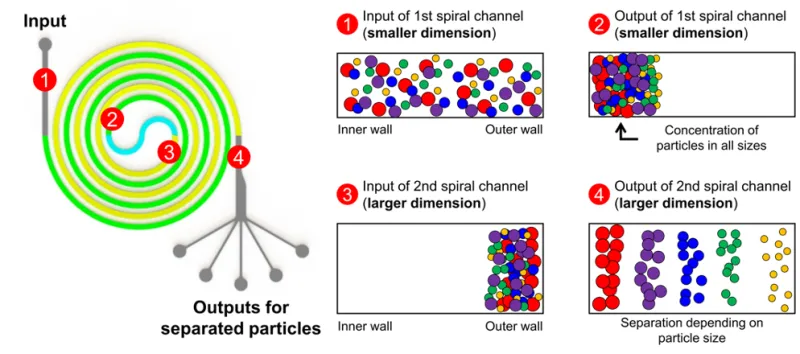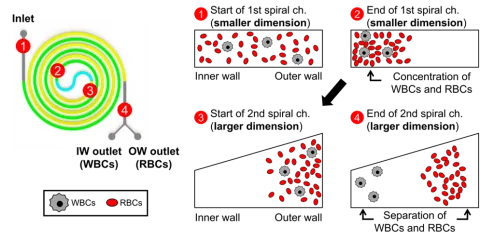Multi-dimensional Double Spiral (MDDS) Device for Integration of Sample Concentration and Separation
This technology is a novel device for sample concentration and separation that can be applied in the biomedical field for size-based isolation of desired cell types from a larger heterogeneous sample such as blood.
Researchers
-
multi-dimensional double spiral device and methods of use thereof
European Patent Convention | Granted | 3,902,630 -
multi-dimensional double spiral device and methods of use thereof
United States of America | Granted | 12,042,792 -
multi-dimensional double spiral device and methods of use thereof
Germany | Granted | 3,902,630 -
multi-dimensional double spiral device and methods of use thereof
France | Granted | 3,902,630 -
multi-dimensional double spiral device and methods of use thereof
United Kingdom | Granted | 3,902,630 -
multi-dimensional double spiral device and methods of use thereof
United States of America | Granted | 11,833,508
Figures
Technology
This technology is a MDDS device enabling both sample concentration and separation in a single device with a one inlet configuration that requires no additional sheath flow. The MDDS device is composed of sequentially connected two spiral channels having two different dimensions. The sample is injected through the inlet, and all the target particles become focused into the inner wall side as they pass through the first smaller-dimension spiral channel due to the strong net lift force. The focused stream in the first spiral channel directly feeds to the outer wall side of the second larger-dimension spiral channel through the S-shaped transition region. In the second spiral channel, due to the increased channel dimension, the net lift force toward the inner wall side become weaker so that target particles have different equilibrium positions depending on their size, resulting in their separation; in general, as particle size increases, the equilibrium position gets closer to the inner wall side. This MDDS device provides high separation resolution and efficiency for a wide variety of particle sizes due to the initial focusing in the first smaller-dimension spiral channel. For example, a blood sample can be loaded into this device to achieve accurate separation of red and white blood cells.
Problem Addressed
Spiral microfluidic devices have been widely used as concentrators and separators for sample preparation. The position of particle focusing is mainly determined by the confinement ratio (CR) which is a ratio of particle diameter to channel hydraulic diameter - smaller channel dimensions enable smaller particles to be focused on the inner wall of the spiral. These devices are widely used as separators for large CR particles but cannot effectively separate small CR particles due to relatively smaller focusing force. To efficiently separate a wider range of CR particles, some devices have two inlets with additional sheath flow. The introduction of two inlets allows the device to achieve increased separation distance, resolution and efficiency, but ultimately increases flow complexity and reduces operating flexibility for a closed-loop system. The present invention is multi-dimensional double spiral (MDDS) device that enables concentration and separation of samples using a single inlet configuration to improve separation resolution and efficiency with a wide target size range.
Advantages
- High-throughput isolation of differentially sized particles from biological samples
- High separation resolution and efficiency
- Simple single-input operation
Publications
Hyungkook Jeon, et al. Fully-Automated and Field-Deployable Blood Leukocyte Separation Platform Using Multi-Dimensional Double Spiral (MDDS) Inertial M. Lab on a Chip. 2020 Aug 25
License this technology
Interested in this technology? Connect with our experienced licensing team to initiate the process.
Sign up for technology updates
Sign up now to receive the latest updates on cutting-edge technologies and innovations.

